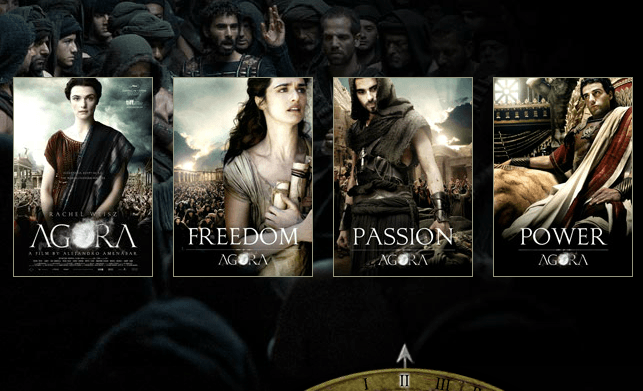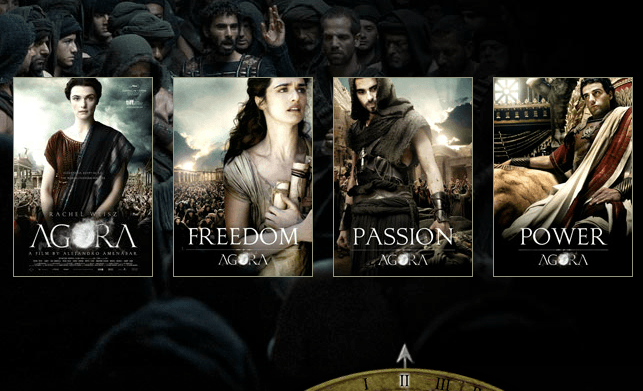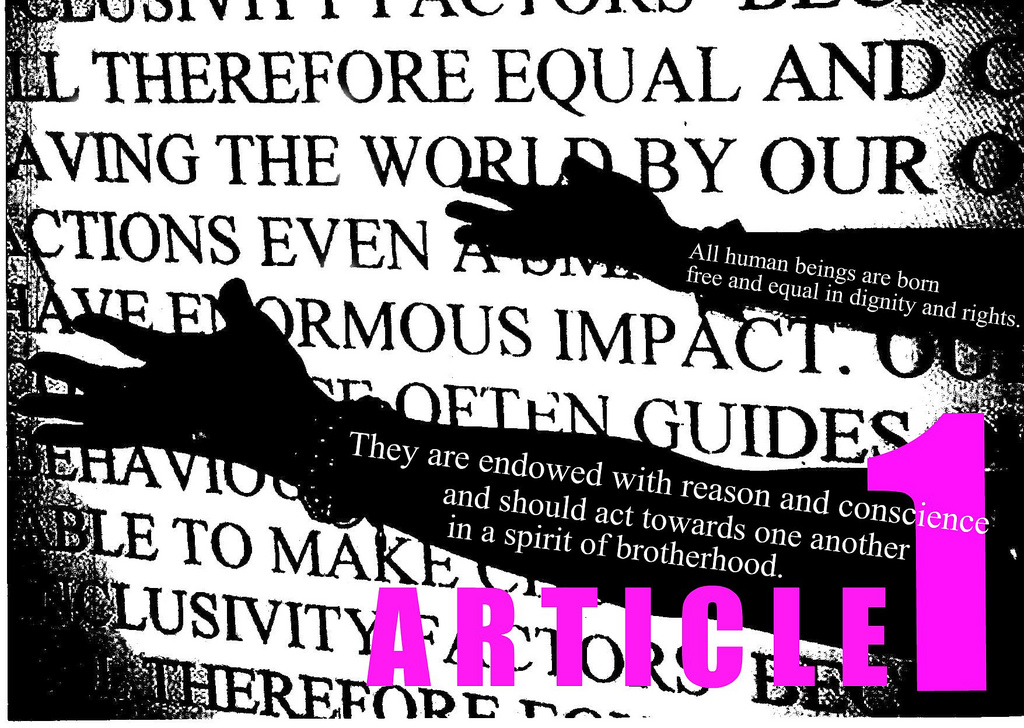
Agora movie – seeing ourselves through an alien past

The movie Agora (director Alejandro Amenábar) is not history, but perhaps, it rises to allegory. It is well worth watching, despite its ‘interpretative’ approach to history. It is a movie which captures deeper truths about human relationships and its fictionalized past helps us understand the challenges of our conflicted present. The struggles of Agora’s characters are enriched by Dario Marianelli’s haunting film score and the movie’s epic intellectual and scenic setting.
Agora takes us to the unfamiliar world of fourth century Alexandria. It is a world being overtaken by change. Certainties of a pagan past are fading as new Christian ways of being emerge. It is a world beset with problems of division and conflict – particularly in the form of religious intolerance and violence. The central character, Hypatia, (played by Rachel Weisz) is a leading scholar of the city. She tries to bridge the divisions of her city and avoid the dark future threatening her world. And religious divisions are not the only problems facing the city. It is a world in which slavery is so normal as to be invisible and a chasm separates rich from poor. Hypatia’s slave, Davos (Max Minghella) is in many ways, Hypatia’s closest companion. Yet she fails to see him as a fellow human being. Davos in his own way is caught in the city’s conflicts. He also struggles to find his way as the city descends into division and violence.
Some interpret Agora as wholly anti-religious, specifically anti-Christian. Certainly this is a strong theme in the movie, but this oversimplifies the movie’s nuanced explorations. The characters evoke images familiar from 21st century news reports — clearly intending to do so — and are more directed to extremism in our own times than in the past. And while only a few of the movie’s portrayals belong historically in 4th century Alexandria (particularly Hypatia’s fate), the movie collapses together events from a thousand years of history – bringing together echoes from other times and places in Alexandria’s ancient marketplace.
Explorations of negative aspects of human nature are in dialogue with the movie’s cross narrative of astronomy and discovery – which in the movie represent the best of which human beings have been and might be capable: the search for new knowledge, and the expression of beauty, harmony and unity.
As the city spirals downward, Hypatia soars upward towards mathematical and astronomical truths – seeking to solve the mystery of the planets who wander across the sky in intricate and ill explained patterns. She draws on mathematical principle to give expression to a deep interrelation among human beings. She teaches her pagan and Christian students that they are equal to each other drawing on Euclid’s first axiom. “If two things are equal to a third thing, they are equal to each other”. “Are you not both equal to me”, she says to two of her students – who concede her point. She concludes “You are equal to each other. We are all brothers.” Here, and in Hypatia’s devotion to knowledge, we see a “spiritual” stream in the movie. Nor is Agora unrelievedly negative in its portrayal of the religious – most notably in its ‘Miracle of the Bread’ which shows human beings, inspired by religion, sacrificing their own welfare for the welfare of others. The movie is about human transcendence and human fallibility. Both found everywhere.
In juxtaposing science and religion the movie invites us to think about the relationship between the two – although its implicit conclusion that they are inimical to each other is seriously flawed on both historical and philosophical grounds.
A central narrative of Agora – that with the arrival of Christianity science came to an end – is historically mistaken. Civilization did not end in the 4th century – although this myopic narrative is sometimes uncritically accepted in western Europe. In part, the assertion reflects a cultural bias towards a triumphalist vision of Western European history which imagines that between European modernity and the classical world there was nothing but the benighted ignorance of a church dominated dark age.
In reality, in the fourth century, the now Christian Roman Empire, continued for centuries (in the form of Byzantium) and much of the learning of ancient times was preserved there. More directly pertinent to the city of Alexandria, its fourth century was in no way followed by a dark age. The opposite is true. Egypt continued to be a centre where sciences, arts, mathematics and medicine flourished and indeed advanced in (as it happened, deeply religious Islamic times) well into the middle ages. We see this for example in the life of the scientist Ibn Haytham, six hundred years after the movie is set, whose optics informed later European science. This is to say nothing of China and India as continuing centres of civilisation, in the times which Agora suggests a bleak age of ignorance. Even in Europe itself, scientific and religious thought were deeply intertwined and evolving in new directions well into the 16th century (at the most conservative).
A second major premise that is suggested by Agora – an implicit equivalence between religion and ignorance, is also historically flawed. Indeed, the proposed dichotomy between religion and knowledge is a conceit of the modern day – ancient philosophers and scholars had no such conceit. For example, although the sources are limited and unclear, there is enough in them for the Smithsonian magazine to attribute Neoplatonism (a metaphysical – that is religious body of thought) to Hypatia herself. In other words, Agora’s modernist secular portrayal of Hypatia is anachronistic and likely misplaced. Moreover, the knowledge of the ancient Greeks flowed into the Islamic world, courtesy of the Syriac versions of writings of Aristotle and others, preserved by Christian scholar monks; and later state sponsored translations into Arabic. Similarly, centuries later, the collected ancient and Islamic era works were translated from Arabic into Latin in the city of Toledo, to enter the early universities of Europe. Again scholar monks were a prominent part of the story.
The suggested dichotomies don’t bear close examination.
This can also be seen for example in some of the contributors to human rights in recent centuries, who were definitively motivated by their religious commitments. Among them were Lucretia Mott, an early feminist and abolitionist. Another, in the 1960’s, is the widely known Rev Dr Martin Luther King Jnr, a baptist minister. The civil rights movement with which the work of his church was so centrally associated was arguably the lynchpin that enabled the translation of human rights concepts in international instruments into real life implementation in the daily lives of men and women around the world. To recent times the Christian impulse has made positive contributions to the world. Beyond the western context, we may also note the figure of Mahatma Gandhi, another figure whose contributions to social progress, were religiously derived.
It is for reasons such as the above, that it is better to view Agora as allegory.
Agora’s uplifting portrayal of science also invites us to consider the reality of science in more detail. The nature of science itself has been the subject of careful enquiry since the twentieth century. In Agora, Hypatia is shown engaged in one of the primary activities of science – puzzle solving. Her thought unfolds within a Ptolemaic paradigm in which the Earth is at the centre of the universe. Motion on the Earth is linear (towards the centre) while motion in the heavens is circular. The solutions for which she reaches, and which in history emerge with Copernicus, Kepler and Galileo, imply the abandonment of this Ptolemaic paradigm. In short they imply a scientific revolution in which old scientific ways of “knowing” are replaced by new scientific frames of reference. Philosophers of science such as Thomas Kuhn and Imre Lakatos, and others, have deepened our understanding of the ways of science. At one point in the movie, Hypatia states that while she does not know how, a certain proposition “can be refuted”. This ‘falsification’ view of science was particularly popularised by Karl Popper, to whom Kuhn and Lakatos responded. Their new scholarship about science, among other things, enables us to refine our understanding of the relationship between science and religion. Many of the observations made by Kuhn and Lakatos, might equally be applied to religion.
Finally, Agora might also have asked a more interesting question. Rather than inviting the palpably incorrect conclusion that “Christianity caused the collapse of civilisation,” as civilisation manifestly continued, it might have asked the potentially more useful question: “Why did Christianity fail, in the 4th century Roman context, in its transformative potential?” This question is hinted at in the movie, but not really explored. As Orestes (a student of Hypatia who later becomes Christian himself and the governor of the city) laments, “How naive of me to think we had finally changed“. It is an observation that invites fatalism. In the 21st century, it is not enough to observe that so many promises – so many projects for a better future – have failed. It is also true that many idealistic projects have succeeded. We have changed – perhaps not yet enough and not yet everywhere, and not sufficiently in certain respects, but certainly fatalism is not warranted. Where failure has been the experience, it is important to understand why and how. Such understanding may allow us to learn how to avoid past mistakes and see how to deliver on the unfulfilled hopes of so many human beings who continue to suffer the consequences of human fallibility. The promises made in documents such as the UN Charter and the Universal Declaration of Human Rights remain to be fulfilled.
Looking beyond the historical inaccuracies of Agora there is a depth to this movie. Its love of astronomy and mathematics are translated into insights about the human condition. Few characters in Agora are caricatured. Most of them show the promise and flaws of humanity. Hypatia, the movie’s central and lauded symbol of enlightenment and brotherhood, has a deep blind spot and prejudice towards the slaves who form part of her life. Such behaviours, symbolising the broader behaviours of an elite of which she was part, form an explanatory context for the change that swept her society. Similarly Davos is a character full of potential and of fallibility. Through him however Amenábar invites us to see the world of Alexandria through the eyes of a slave. These are just small examples of where the movie succeeds.







